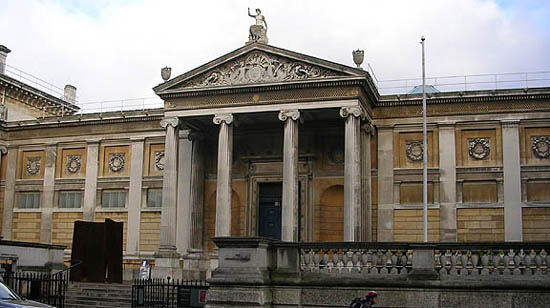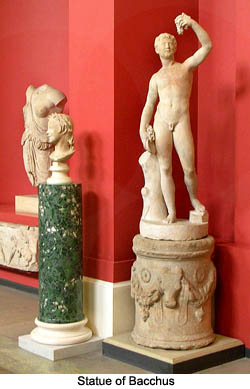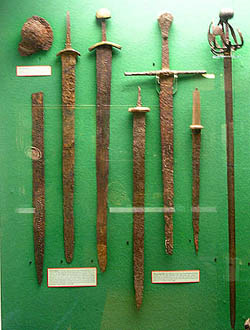The Ashmolean Museum: Oxford's Window on the Ancient World
by Sean McLachlan
Oxford offers the visitor a chance to stroll through one of the
world's oldest university towns, along streets steeped in
history. The architecture of the colleges, the bustle of busy
intellectual life, and the fine shopping attract people from
around the world. But the town is also home to some world-class
museums. The Ashmolean, founded in 1683, is the oldest public
collection in England. While the British Museum is larger and
more famous, the Ashmolean should not be missed. It boasts a wide
variety of permanent collections and special exhibits, and is
generally less crowded than its London rival, allowing the
visitor time to reflect.

The Ashmolean is located in the heart of Oxford in a fine
Neoclassical building. Directly inside the entrance is a wide
hall lined with Greek and Roman sculpture. Satyrs, maenads and
other playful figures of Classical mythology face several
stern-faced Roman aristocrats who frown on their antics with
ancient disapproval. Read the labels and you'll find
just how enduring Classical sculpture was. Many of the Roman
pieces are copies of earlier Greek originals. The Romans, despite
conquering Greece, respected Hellenic culture. Many of the
sculptures here were restored centuries later in the Renaissance,
when European art partially broke away from Church domination.
The two most elaborate sculptures in the hall, a pair of
two-meter-tall marble candelabra flanking the entrance, are even
more modern. They were made in Italy in the 18th century.
They are imitations of candelabra used in Rome two thousand years
ago. A few bits of ancient carving were incorporated into their
construction. If you look closely you can tell the difference
between new and old in these giant jigsaw puzzles.
 Beyond the sculpture hall are the most popular rooms,
those dedicated to ancient Egypt. You might have to jostle for
position with swarming school groups, but you can resign yourself
to the fact that you can at least see over their heads! Beyond the sculpture hall are the most popular rooms,
those dedicated to ancient Egypt. You might have to jostle for
position with swarming school groups, but you can resign yourself
to the fact that you can at least see over their heads!
The sheer number and variety of artifacts the Ashmolean has
collected over the years is dazzling. There are literally
hundreds of statuettes, seals, pots, and amulets on display.
While austere carvings and gold mummy cases are what makes
Egyptian art famous, the Ashmolean has many artifacts that give
insight into daily life of the period. One display shows wooden
figurines that were placed in tombs and preserved for thousands
of years by the arid climate. These images of servants were meant
to come to life and care for their master in the afterworld. A
woman grinds grain to make bread. A group of men brew beer. In a
model granary, a burly crew fills sacks from rooms still filled
with ancient seeds. Nearby, two boats sail on a forgotten wind,
ready to take the deceased through the Underworld.
Another room carries the ever-popular mummies, but even more
impressive is the shrine of the pharaoh Taharqa 690-664 BC. The
shrine, which was shipped complete from Egypt, was part of the
larger temple at Kawa, dedicated to Amun-Re, known as the
"father of the gods, the fashioner of men, the creator of
cattle, the lord of all being."
For more local antiquities, there are several good halls. On the
ground floor is a selection of everyday objects from early
England. Here are fearsome weapons from the medieval days, clay
pipes smoked in 17th-century coffeehouses when both coffee and
tobacco were new fads, painted floor tiles showing scenes from
the Bible, and an array of tradesmen's tools.
 Two fascinating
cases hold a collection of wine bottles. First introduced in the
1630s, their shapes vary and most have makers' marks on the side,
allowing historians to figure out their date of manufacture. They
are ranked chronologically, so you can see how their form changed
over time. Half of the collection is made up of bottles shipped
to Oxford's various colleges and marked with their crests or
initials. Colleges had vast wine cellars and stocked bottles by
the thousands. Trinity College used broken bottles to line the
top of their outer wall to keep undergraduates from climbing in
after the gates closed for the night. Apparently a plentiful
stock of wine wasn't enough to keep the students from spending
late hours at the local pub. Two fascinating
cases hold a collection of wine bottles. First introduced in the
1630s, their shapes vary and most have makers' marks on the side,
allowing historians to figure out their date of manufacture. They
are ranked chronologically, so you can see how their form changed
over time. Half of the collection is made up of bottles shipped
to Oxford's various colleges and marked with their crests or
initials. Colleges had vast wine cellars and stocked bottles by
the thousands. Trinity College used broken bottles to line the
top of their outer wall to keep undergraduates from climbing in
after the gates closed for the night. Apparently a plentiful
stock of wine wasn't enough to keep the students from spending
late hours at the local pub.
Upstairs is a large gallery filled with Celtic and Anglo-Saxon
antiquities from England. One wall is covered with grave goods
from Anglo-Saxon cemeteries. Here you can see the weapons and
jewelry that men and women went to the afterlife with. The
jewelry shows an odd variation of taste. Elaborately crafted gold
brooches sit next to clunky and garish bead necklaces that
resemble cheap costume jewelry from the 1970s.
The prize piece in this collection is the famous Alfred Jewel. A
clear, tear-shaped crystal is encased in granulated goldwork.
Within the crystal is a wide-eyed figure made of colored enamel,
said by historians to symbolize the sense of sight. The jewel was
probably the head of a pointer used to assist in the reading of
religious texts. The jewel gets its name from an inscription
running around the frame: "AELFRED MEC HEHT GEWYRCAN",
which translates to "Alfred ordered me made." This
probably refers to Alfred the Great, the first Anglo-Saxon king
to unify much of England and a great patron of learning and
literacy.
Space prohibits even a cursory description of all the Ashmolean
has to offer -- but you can click Here for a gallery of images
from the museum. Highlights include a gallery dedicated to Greek
vases, another for Chinese porcelain, Asian sculptures, a small
but educational coin room, and a collection of prehistoric
artifacts from around the world. Don't forget the two Viking
runestones hidden in the stairwell!
Related Articles:
- Oxford's Museum of the History of Science, by Sean McLachlan
- https://www.timetravel-britain.com/articles/museums/science.shtml
- Oxford: A Melange of Magic, Myth and Martyrs, by Sue Kendrick
- https://www.timetravel-britain.com/articles/towns/oxford.shtml
More Information:
We regret that we no longer have the resources to maintain up-to-date links and/or hours and pricing details for the various sites and attractions listed on this website. For more information about the location(s) listed above, please use your favorite search engine or visit Wikipedia.
Article © 2006 Sean McLachlan
Photos © Almudena Alonso-Herrero.
| 